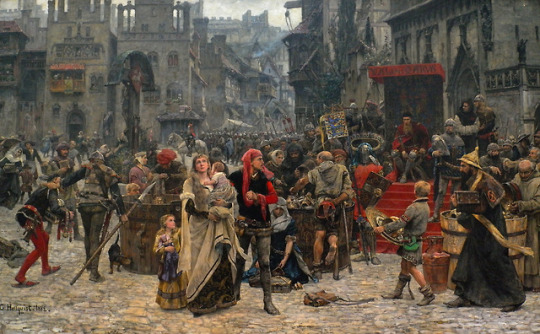#Valdemar Atterdag
Explore tagged Tumblr posts
Text
𓃶 What Is The Wild Hunt?
The Wild Hunt is a common belief among many Northern European cultures. In short, the hunt is a cavalcade of ghosts, spirits, fairies, elves, and other spiritual beings that is said to sweep across our world every year. Depending on where your beliefs come from, when it happens will differ.
It is commonly believed that the leader of The Wild Hunt is a deity or figure of importance of some kind, such as Odin/Woden in Norse and Saxon traditions, or King Arthur in British lore. Other leaders of the hunt include but are not limited to:
𖤓 Arawn or Gwyn ap Nudd, commonly seen as the Welsh lords of Annwn
𖤓 Danish king Valdemar Atterdag
𖤓 The Norse dragon slayer Sigurd
𖤓 Biblical figures like Cain, Gabriel, Herod and the devil
𖤓 Gothic king Theodoric the Great
☾༺♰༻☽
𓃶 What Did People Do For The Wild Hunt?
The Wild Hunt was generally seen as a bad omen; one for destruction, famine, war, plague, or the death of the one who saw it. In many traditions, witnessing the hunt would result in the viewer being abducted to Otherworld or Underworld. Other times, those who were not protected would have their souls pulled from their bodies while they sleep, and they would join the menagerie of the dead.
To avoid this fate, people in Wales, for example, began the tradition of carving pumpkins as a way to avoid being taken by the fae. In Scandinavia, offerings like bread were put outside the home as an offering to the spirits joining Odin for the hunt.
☾༺♰༻☽
𓃶 When is The Wild Hunt?
Depending on where your beliefs stem from, there are various answers to this question.
In Britain, The Wild Hunt is associated with the autumn season, specifically around and on Samhain/The Autumn Equinox.
Scandinavian tradition tells us that they prepared for the hunt around December, specifically Yule/The Winter Equinox.
☾༺♰༻☽
𓃶 What Entities Are A Part of the Wild Hunt?
Many entities are associated with the Wild Hunt in different areas. These entities include but are not limited to:
𖤓 The Fae (The Sidhe, The Tlywyth Teg, etc)
𖤓 Spirits of the Dead
𖤓 Demons
𖤓 Valkyries
𖤓 The Spirits of Huntsmen or Nobles
𖤓 Horses (sometimes with an abnormal amount of legs)
𖤓 Wolves and dogs (sometimes spiritual in nature, i.e. the Cwn Annwn)
☾༺♰༻☽
#pagan witch#paganism#witchblr#witchcraft#the wild hunt#king arthur#avalon#gwyn ap nudd#arawn#welsh mythology#norse mythology#norse paganism#fairies#fae folk#fae#faerie#ghost#spirituality#celtic paganism
682 notes
·
View notes
Text


It's getting better
I drew based on an illustration of how the danish king Valdemar IV Atterdag collected tribute from the town of Visby (I'll tell about this event later). But it was very difficult to draw the coat of arms of Denmark, that's why it��� very different.
28 notes
·
View notes
Text
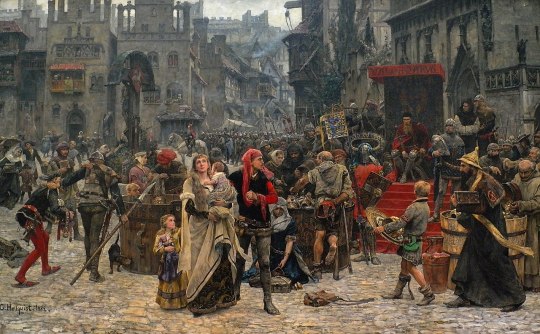


Carl Gustaf Hellqvist
Carl Gustaf Hellqvist - Valdemar Atterdag Holding Visby to Ransom 1361 (1882) "Valdemar Atterdag brandskattar Visby den 27 juli 1361" Óleo sobre lienzo, 200 cm × 330 cm Pintura histórica
Esta pintura muestra cómo el rey danés Valdemar IV (también conocido como Valdemar Atterdag) recolecta tesoros de la gente en la ciudad medieval de Gotlandic de Visby en el verano de 1361 después de la Batalla de Visby . Si la gente del pueblo no llena las tres grandes tinajas de cerveza con oro, plata y otras riquezas, Valdemar se encargará de que todo el pueblo sea quemado hasta los cimientos. Este tipo de tributación se conoce como fire taxation ( en sueco: brandkattning ).
El rey Valdemar Atterdag se sienta a la derecha, en un trono rojo elevado frente a la gran iglesia de Santa Catalina, y observa a los habitantes del pueblo mientras corren para llenar las tinas. En el centro del cuadro se ven los personajes principales, es decir, el alcalde y su familia. El alcalde aprieta el puño con ira y mira al rey danés, mientras su esposa mira hacia el cielo, hacia Dios. La esposa hace el papel de la Virgen María , y tiene una lágrima en el rabillo del ojo
"Valdemar Atterdag retiene a Visby como rescate, 1361" o "Valdemar Atterdag impone un impuesto a Visby, 1361" recibió una medalla de oro en Viena, Austria, en 1882 y ahora forma parte de las colecciones del Museo Nacional de Bellas Artes de Estocolmo , Suecia .
📍Nationalmuseum Stockholm, Sweden
3 notes
·
View notes
Text
15 juin : le Danemark célèbre son drapeau
Au début du XIIIe siècle, le roi danois Valdemar Sejr (Valdemar le Victorieux) mena son armée en croisade dans l'actuelle Estonie. Lors d'une bataille le 15 juin 1219, les Danois étaient sur la défensive quand soudain une bannière rouge avec une croix blanche tomba du ciel. En conséquence, la chance a changé de camp. Non seulement l’armée danoise a gagné, mais le Danemark avait désormais un drapeau.
La bataille de Lyndanisse, en 1219, contre l'Estonie a bien eu lieu, mais l’histoire du drapeau, on s’en doute, est totalement légendaire. Cela n’a pas empêché, en 2019, le Danemark de célébrer en grande pompe le 800e anniversaire de son drapeau. Celui-ci est appelé le Dannebrod (le drap des Danois).
Le drapeau danois n'a pas toujours été danois. Lors des croisades européennes du XIe au XIIIe siècle au Proche Orient, un drapeau rouge avec une croix blanche était fréquemment utilisé, sans lien avec le Danemark. Il est devenu un drapeau danois vers le milieu du XIVe siècle, ce qui en fait l'un des plus anciens drapeaux nationaux du monde toujours en vigueur. Il fut adopté, à l’époque, par le roi danois Valdemar Atterdag, probablement inspiré par l'empereur romain germanique, Louis IV de Bavière, qui utilisait un drapeau similaire.
Depuis 1913, le drapeau et la légende de son origine, sont célébrés chaque année le 15 juin. Cette journée du drapeau est appelée Valdemars Dag (le jour de Valdemar). Ce jour-là, et ce n’est pas la seule occasion, le drapeau est hissé dans tout le pays. Les écoles, les organisations sportives et les troupes de scouts au Danemark organisent souvent des concours le 15 juin, également connu sous le nom de Jour du drapeau, au cours desquels ils reconstituent l'histoire du Dannebrog (le drapeau danois) et celle du roi Valdemar. Le drapeau rouge et blanc flotte partout ce jour-là.
Un autre évènement s’est produit un 15 juin, c’était en 1920, la récupération par le Danemark du Schleswig du Nord. Cette région qui était disputée par l’Allemagne et le Danemark, avait été à l’origine de deux guerres, en 1848 et en 1864. Elle a été finalement partagée entre les deux pays, après un référendum. L’évènement est célébré chaque année localement.
#Dannebrod #valdemarsdag
Un article de l'Almanach international des éditions BiblioMonde
0 notes
Text
valdemar atterdag er det mest superskurkete historiske navnet jeg har vært borti
#leser mye om skandinavisk middelalder nå til bacheloren#er så lei men jaja#snart ferdig#🦦#norsk posting
0 notes
Photo
Valdemar Atterdag holding Visby to ransom, 1361 by Carl Gustaf Hellqvist in 1882.
This painting depicts how the Danish king Valdemar IV (a.k.a. Valdemar Atterdag) collects treasures from the people in the Gotlandic medieval town of Visby in the summer of 1361 following the Battle of Visby. If the town's people do not fill the three big beer vats with gold, silver and other riches, Valdemar will see to that the whole town is burned to the ground. This type of taxation is known as fire taxation (Swedish: brandskattning).
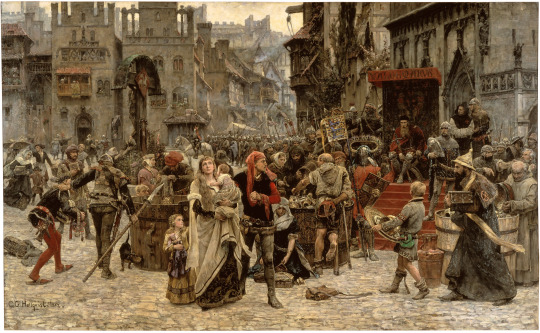
30 notes
·
View notes
Text
The Wild Hunt-Fionn-First Gods
Disclaimer: I'm not saying I'm right about all of this. Just theorizing here.
This is gonna be long post so buckle up...
Because this is a long post I’m gonna write what I’m gonna talk about in this post. Also not every myth points to one thing and not every thing we have in the books are inspired just one thing. To me it looks like sarah used different myths from different countries and connected them all together.
The Wild Hunt myths and how sarah might use them for plot for the next books and crossover
First gods are still running free in the world
Narben is actually a spear not a sword? Or fourth dread trove is a spear?
Fionn is not dead but sleeping?
Fionn is(was) the leader of wild hunt and betrayed the Daglan.
Let’s start....
The Wild Hunt
It is described like this in mythology
The Wild Hunt is a folklore motif that occurs in the folklore of various northern European cultures. Wild Hunts typically involve a chase led by a mythological figure escorted by a ghostly or supernatural group of hunters engaged in pursuit. The leader of the hunt is often a named figure associated with Odin in Germanic legends, but may variously be a historical or legendary figure like Theodoric the Great, the Danish king Valdemar Atterdag, the Welsh psychopomp Gwyn ap Nudd, biblical figures such as Herod, Cain, Gabriel, or the Devil, or an unidentified lost soul or spirit either male or female. The hunters are generally the souls of the dead or ghostly dogs, sometimes fairies, valkyries, or elves.
and this is from Acosf
“The Daglan delighted in terrorizing the Fae and humans under their control. The Wild Hunt was a way to keep all of us in line. They’d gather a host of their fiercest, most merciless warriors and grant them free rein to kill as they pleased. The Daglan possessed mighty, monstrous beasts—hounds, they called them, though they didn’t look like the hounds we know—that they used to run prey to ground before they tortured and killed them. It’s a terrible history, and much of it might be elaborated myths.” (Acosf)
I think the reason we got Valkyries plot in Acosf sarah is going to connect to wild hunt. But the whole Wild Hunt plot is not only about that.
In Acosf we met Lanthys. He is one of the First gods. (thank to @lesolehabitantdelalune for showing me this quote because without her I wouldn't catch this.)
Cassian took a bite of food. A good sign that this, at least, was acceptable territory. “When you lived in the human world, you had legends of the dread beasts and faeries who would slaughter you if they ever breached the wall, didn’t you? Things that slithered through open windows to drink the blood of children? Things that were so wicked, so cruel there was no hope against their evil?” The hair on her neck rose. “Yes.” Those stories had always unnerved and petrified her. “They were based on truth. Based on ancient, near-primordial beings who existed here before the High Fae split into courts, before the High Lords. Some call them the First Gods. They were beings with almost no physical form, but a keen, vicious intelligence. Humans and Fae alike were their prey. Most were hunted and driven into hiding or imprisonment ages ago. But some remained, lurking in forgotten corners of the land.” He swallowed another mouthful. “When I was nearing three hundred years old, one of them appeared again, crawling out of the roots of a mountain. Before he went into the Prison and confinement weakened him, Lanthys could turn into wind and rip the air from your lungs, or turn into rain and drown you on dry land; he could peel your skin from your body with a few movements. He never revealed his true form, but when I faced him, he chose to appear as swirling mist. He fathered a race of faeries that still plague us, who thrived under Amarantha’s reign—the Bogge. But the Bogge are lesser, mere shadows compared to Lanthys. If there is such a thing as evil incarnate, it is him. He has no mercy, no sense of right or wrong. There is him, and there is everyone else, and we are all his prey. His methods of killing are creative and slow. He feasts on fear and pain as much as the flesh itself.”(acosf)
So we learn quiet a few things from this quote.
Lantys is a first god.
First gods were near-primordial beings who existed before the High Fae split into courts, before the high lords.
They were beings with almost no physical form, but a keen, vicious intelligence.
But some First gods remained, lurking in forgotten corners of the land.”
These are all important.
Later we find that Lanthys was a part of the Wild Hunt.
“Oh, I do not think so,” Lanthys seethed. “I rode in the Wild Hunt before you were even a scrap of existence, witch from Oorid. I summoned the hounds and the world cowered at their baying. I galloped at the head of the Hunt, and Fae and beast bowed before us.”(acosf)
Before we dive more into to the Wild Hunt I wanna show this.
The description of the First Gods (with almost no physical form, lurking in forgotten corners of the land.”)reminded me of something. I think this is a scene as a fandom we find not important but I think it might be one of the biggest hints?
that scene happens in Acofas. In Mor's chapter.
But Mor scented nothing, saw nothing. The tendril of power she speared toward the woods revealed only the usual birds and small beasts. A hart drinking from a hole in an iced-over stream. Nothing, except—.There, between a snarl of thorns. A patch of darkness. It did not move, did not seem to do anything but linger. And watch. Familiar and yet foreign. Something in her power whispered not to touch it, not to go near it. Even from this distance. Mor obeyed. But she still watched that darkness in the thorns, as if a shadow had fallen asleep amongst them. Not like Azriel’s shadows, twining and whispering. Something different. Something that stared back, watching her in turn. Best left undisturbed. Especially with the promise of a crackling fire and glass of wine at home. “Let’s take the short route back,” she murmured to Ellia, patting her neck. The horse needed no further encouragement before launching into a gallop, turning them from the woods and its shadowy watcher. Over and between the hills they rode, until the woods were hidden in the mists behind them. What else might she see, witness, in lands where none in the Night Court had ventured for millennia?(acosf)
She sees a shadows... and what we know about the first gods? with almost no physical form.
She was in the lands where none in the Night Courth had ventured for Millennia... what we know about the first gods? lurking in forgotten corners of the land.
Did she saw a First God? Are there more like it? Why mor was the one to see it? I will talk about mor more later in the post but a little hint... it is interesting that The Morrigan is called ""great queen" or "phantom queen" in myths.
Okay back to Wild Hunt.
In Wikipedia it shows that in different countries the leader of the wild hunt is different.
I'm gonna talk about two of them in this post.
Brittany: Arthur
Ireland: Fionn mac Cumhaill and the Fianna; Manannán—also known as The Fairy Cavalcade.
Brittany:Arthur
We are starting with Brittany:Arthur. (I added the wiki page if you want to read about more because I can't talk about everything.
I think Sarah used this legend as a part of Gwydion-TT-Narben.
Arthur was the King. I think the most popular myth about this is Excalibur and Sword in the stone(some stories say they were one and the same)
Excalibur is the legendary sword of King Arthur, sometimes also attributed with magical powers or associated with the rightful sovereignty of Britain. It was associated with the Arthurian legend very early on. Excalibur and the Sword in the Stone are not the same weapon, though in some modern incarnations they are either the same or at least share their name.
Now let's look at Gwydion.
“Some strains of the mythology claim that one of the Fae heroes who rose up to overthrow them was Fionn, who was given the great sword Gwydion by the High Priestess Oleanna, who had dipped it into the Cauldron itself. Fionn and Gwydion overthrew the Daglan. A millennium of peace followed, and the lands were divided into rough territories that were the precursors to the courts—but at the end of those thousand years, they were at each other’s throats, on the brink of war.” His face tightened. “Fionn unified them and set himself above them as High King. The first and only High King this land has ever had.”(acosf)
From Hosab we know that Gwydion is actually Starsword.
It was its twin. The Starsword began to hum within its sheath, glittering white light leaking from where leather met the dark hilt. The dagger—.The male dropped the dagger to the plush carpet. All of them retreated as it flared with dark light, as if in answer. Alpha and Omega. “Gwydion,” the dark-haired female whispered, indicating the Starsword.(hosab)
Other things we know about Gwydion(Starsword)
That your son, not you, retrieved the Starsword from the Cave of Princes in Avallen’s dark heart. That your son, not you, stood among the long-dead Starborn Princes asleep in their sarcophagi and was deemed worthy to pull the sword from its sheath. How many times did you try to draw the sword when you were young? How much research did you do in this very study to find ways to wield it without being chosen? (Hoeab)
like Arthur, Ruhn was the one to pull it out.
But we know that the sword actualy belongs to female heir of Theia.
“Theia was dead by that point,” Aidas said flatly. “Pelias slew her.” He nodded to the Starsword in Ruhn’s hand. “And stole her blade when he’d finished.” He snarled. “That sword belongs to Theia’s female heir. Not the male offspring who corrupted her line.”
@offtorivendell talks about this in this post if you wanna read it. Theia's secret legacy
so how this connects to Truth-Teller and Narben?
Arthur had two other weapons.
A dagger and a spear.
Other weapons have been associated with Arthur. Welsh tradition also knew of a dagger named Carnwennan and a spear named Rhongomyniad that belonged to him. Carnwennan ("little white-hilt") first appears in Culhwch and Olwen, where Arthur uses it to slice the witch Orddu in half. Rhongomyniad ("spear" + "striker, slayer") is also mentioned in Culhwch, although only in passing; it appears as simply Ron ("spear") in Geoffrey's Historia. Geoffrey also names Arthur's shield as Pridwen; in Culhwch, however, Prydwen ("fair face") is the name of Arthur's ship while his shield is named Wynebgwrthucher ("face of evening").
We know that Truth-teller and Gwydion(Starsword) are twins. Alpha and Omega. (I made a post about this. You can find it here Alphan&Omega)
Now... Narben. We know little about Narben.
“Amarantha destroyed one,” Amren said. Cassian started. “I never heard that.” Amren amended, “Rumor claimed she dumped one into the sea. It would not come to Amarantha’s hand, nor the hands of any of her commanders, and rather than let the King of Hybern attain it, she disposed of it.” Azriel asked, “Which sword?” “Narben.” (Acosf)
"Narben was even older than Gwydion,” Rhys said. “Where the hell was it?” (Acosf)
Narben’s powers had not been the holy, savior’s light of Gwydion, but ones far darker. (Acosf)
Rhys studied her blade. “Narben is a death-sword. It’s lost, possibly destroyed, but stories say it can slay even monsters like Lanthys.” (Acosf)
These are all the things we know. It is a little bit sketchy that Sarah had given us so little information about it.
Also it looks like she is using Arthur's weapons as an inspo for Gwydion and Truth-teller...which one is missing? A spear. So that makes me question if Narben is not a sword but a spear? Or the Fourth dread trove is a spear? 👀
now...we are done with Brittany:arthur as the leader of the wild hunt. this other part is more in depth with the where I think the story is going.
second leader of the wild hunt we are going to talk about :
Ireland: Fionn mac Cumhaill and the Fianna
Ireland: Fionn mac Cumhaill and the Fianna; Manannán—also known as The Fairy Cavalcade.
Fionn mac Cumhaill , often anglicized Finn McCool or MacCool, is a hero in Irish mythology, as well as in later Scottish and Manx folklore. He is leader of the Fianna bands of young roving hunter-warriors, as well as being a seer and poet.
He was a seer...So is Elain. 👀👀
He is often depicted hunting with his hounds Bran and Sceólang("raven" and "survivor”), and fighting with his spear and sword.
in this it is mentioned that he hunts with his hounds. and has a spear? another spear mentioning. Narben is a spear? Or the Fourth dread trove we haven’t found yet is a spear?
From what lanthys said there were hounds in Wild Hunt in Acotar.
“Oh, I do not think so,” Lanthys seethed. “I rode in the Wild Hunt before you were even a scrap of existence, witch from Oorid. I summoned the hounds and the world cowered at their baying. I galloped at the head of the Hunt, and Fae and beast bowed before us.”(acosf)
and nesta says that the hounds Lanthys showed her in the vision looked like the beasts from Court Of Nightmares.
Nesta could see the portrait Lanthys wove into the air around them. She saw herself on a black throne, a matching crown in her unbound hair. Enormous onyx beasts—scaled, like those she’d seen on the Hewn City’s pillars—lay at the foot of the dais. (Acosf)
and these are a few description of the hounds on the Hewn City's pillars.
Great, scaled black beasts were carved into those gates, all coiled together in a nest of claws and fangs, sleeping and fighting, some locked in an endless cycle of devouring each other. Between them flowed vines of jasmine and moonflowers. I could have sworn the beasts seemed to writhe in the silvery glow of the bobbing faelights throughout the mountain-city. The Gates of Eternity—that’s what I’d call the painting that flickered in my mind. (Acomaf)
We at last came to a throne room of polished ebony. More of the serpents from the front gates were carved here—this time, wrapped around the countless columns supporting the onyx ceiling. It was so high up that gloom hid its finer details, but I knew more had been carved there, too. Great beasts to monitor the manipulations and scheming within this room. The throne itself had been fashioned out of a few of them, a head snaking around either side of the back—as if they watched over the High Lord’s shoulder. (Acomaf)
and we have the prophecy from acomaf
Life and death and rebirth Sun and moon and dark Rot and bloom and bones Hello, sweet thing. Hello, lady of night, princess of decay. Hello, fanged beast and trembling fawn. Love me, touch me, sing me. (Acomaf)
continuing with Fionn...
Fionn in the myth literally has the same name as the high king we learned about in acosf.
Rhys’s eyes flicked to Ataraxia, then to Cassian. “Some strains of the mythology claim that one of the Fae heroes who rose up to overthrow them was Fionn, who was given the great sword Gwydion by the High Priestess Oleanna, who had dipped it into the Cauldron itself. Fionn and Gwydion overthrew the Daglan. A millennium of peace followed, and the lands were divided into rough territories that were the precursors to the courts—but at the end of those thousand years, they were at each other’s throats, on the brink of war.” His face tightened. “Fionn unified them and set himself above them as High King. The first and only High King this land has ever had.” (Acosf)
Is it a coincidence that Fionn is the leader of Wild Hunt in myths and we have Fionn in Acosf who rose up to Overthrow the Daglan?
Was the Fionn, from acotar, the leader of the Wild Hunt in acotar?
Rigelus mentions that the fearsome warriors they built were traitors. They joined the Fae and overthrow his siblings.
“Can’t you?” The cold voice slithered through the intercom. “You are Starborn, and have the Horn bound to your body and power. Your ancestors wielded the Horn and another Fae object that allowed them to enter this world. Stolen, of course, from their original masters—our people. Our people, who built fearsome warriors in that world to be their army. All of them prototypes for the angels in this one. And all of them traitors to their creators, joining the Fae to overthrow my brothers and sisters a thousand years before we arrived on Midgard. They slew my siblings.” (Hosab)
“The Daglan delighted in terrorizing the Fae and humans under their control. The Wild Hunt was a way to keep all of us in line. They’d gather a host of their fiercest, most merciless warriors and grant them free rein to kill as they pleased. The Daglan possessed mighty, monstrous beasts—hounds, they called them, though they didn’t look like the hounds we know—that they used to run prey to ground before they tortured and killed them. It’s a terrible history, and much of it might be elaborated myths.”(acosf)
Rhys’s eyes flicked to Ataraxia, then to Cassian. “Some strains of the mythology claim that one of the Fae heroes who rose up to overthrow them was Fionn, who was given the great sword Gwydion by the High Priestess Oleanna, who had dipped it into the Cauldron itself. Fionn and Gwydion overthrew the Daglan. (Acosf)
moving onto myth again. I will be doing a little bit paraphrasing.
In the myth Fionn is the son of Cumhall mac Trénmhoir. Cumhall was the leader of Fianna. The Fianna were a band of warriors also known as a military order composed mainly of the members of two rival clans, "Clan Bascna" (to which Finn and Cumall belonged) and "Clan Morna" (where Goll mac Morna belonged), the Fenians were supposed to be devoted to the service of the High King and to the repelling of foreign invaders. After the fall of Cumall, Goll mac Morna replaced him as the leader of the Fianna, holding the position for 10 years.One feat of Fionn performed at 10 years of age according to the Acallam na Senórach was to slay Áillen, the fire-breathing man of the Tuatha Dé Danann, who had come to wreak destruction on the Irish capital of Tara every year on the festival of Samhain for the past 23 years, lulling the city's men to sleep with his music then burning down the city and its treasures. When the King of Ireland asked what men would guard Tara against Áillen's invasion, Fionn volunteered. Fionn obtained a special spear (the "Birga") from Fiacha mac Congha ("son of Conga"), which warded against the sleep-inducing music of Áillen's "dulcimer" when it was unsheathed and the bare steel blade was touched against the forehead or some other part of the body. This Fiacha used to be one of Cumall's men, but was now serving the high-king.After Fionn defeated Áillen and saved Tara, his heritage was recognised and he was given command of the Fianna: Goll stepped aside, and became a loyal follower of Fionn, although a dispute later broke out between the clans over the pig of Slanga.
Keep Tuatha Dé Danann in mind because I'm gonna use later on--soon.
There is a mention of High King. We know that Fionn was the first and the last high king acotar world saw.
Moving onto Fionn’s death from the myth.
According to the most popular account of Fionn's death, he is not dead at all, rather, he sleeps in a cave, surrounded by the Fianna. One day he will awake and defend Ireland in the hour of her greatest need. In one account, it is said that he will arise when the Dord Fiann, the hunting horn of the Fianna, is sounded three times, and he will be as strong and as well as he ever was.
He is not dead but sleeping. He will wake up when the horn is sounded three times. And you know who just arrived at Acotar with the horn tattooed to her back? BRYCE. Is this all crossover is about. To wake up Fionn from his sleep? This is how the crossover is going to affect the Acotar world? Is Fionn good or bad?
“Can’t you?” The cold voice slithered through the intercom. “You are Starborn, and have the Horn bound to your body and power. Your ancestors wielded the Horn and another Fae object that allowed them to enter this world. Stolen, of course, from their original masters—our people.
Rigelus says that the horn was stolen from his people. The Daglan. And the wild hunt was their way to terrorize the fae. And if fionn betrayed them and rose againts them...he might have stolen the horn from them?
In the myth Fionn was the leader of Fianna.
Fianna were small warrior-hunter bands in Gaelic Ireland during the Iron Age and early Middle Ages. A fian was made up of freeborn young males, often aristocrats, "who had left fosterage but had not yet inherited the property needed to settle down as full landowning members of the túath". For most of the year they lived in the wild, hunting, raiding other communities and lands, training, and fighting as mercenaries. Scholars believe the fian was a rite of passage into manhood, and have linked fianna with similar young warrior bands in other early European cultures
Fian was a Rite of passage into manhood? does that sound familiar? hello...Blood rite.
“What’s the Blood Rite?” “What it sounds like.” He rubbed his neck. “When an Illyrian warrior comes into his full power, usually in his twenties, he has to go through the Blood Rite before he can qualify as a full warrior and adult.
It seems like sarah took inspo from here.
And you know which mountain is sacred for Illyrians...RAMIEL.
and you know how ramiel was described.
Ramiel. The sacred mountain. The heart of not only Illyria, but the entirety of the Night Court.
Cassian soared toward it, unable to resist Ramiel’s ancient summons. Different—the mountain was so different from the barren, terrible presence of the lone peak in the center of Prythian. Ramiel had always felt alive, somehow. Awake and watchful.
Felt alive somehow? Is it because Fionn is sleeping in there? With Fianna?
Ramiel rose higher still, a shard of stone piercing the gray sky. Beautiful and lonely. Eternal and ageless. No wonder that first ruler of the Night Court had made this his insignia. Along with the three stars that only appeared for a brief window each year, framing the uppermost peak of Ramiel like a crown. It was during that window when the Rite occurred. Which had come first: the insignia or the Rite, Cassian didn’t know. Had never really cared to find out. (Acofas)
The thing Cassian says about the insignia is really interesting. Which one came first? The rite? or the insignia?
We know that the courts took place after the fall of Fionn in Acotar.
Rhys’s eyes flicked to Ataraxia, then to Cassian. “Some strains of the mythology claim that one of the Fae heroes who rose up to overthrow them was Fionn, who was given the great sword Gwydion by the High Priestess Oleanna, who had dipped it into the Cauldron itself. Fionn and Gwydion overthrew the Daglan. A millennium of peace followed, and the lands were divided into rough territories that were the precursors to the courts—but at the end of those thousand years, they were at each other’s throats, on the brink of war.” His face tightened. “Fionn unified them and set himself above them as High King. The first and only High King this land has ever had.” Nesta could have sworn the last words were spoken with a sharp look toward Cassian. But Cassian only winked at Rhys. “What happened to the High King?” Feyre asked. Rhys ran a hand over a page of the book. “Fionn was betrayed by his queen, who had been leader of her own territory, and by his dearest friend, who was his general. They killed him, taking some of his bloodline’s most powerful and precious weapons, and then out of the chaos that followed, the seven High Lords rose, and the courts have been in place ever since.”
My theory is that...THE SECOND DAUGHTER was the first ruler of night court.
Did she come back to Acotar and was the first ruler of the Night court? @silverlinedeyes talks about in "The Illyrians—A (Crack) Theory" how illyrians might be demons from hel and the second daughter came back to the acotar with them.
in Hosab we learn that Theia was the queen who betrayed Fionn and she crossed to Crescent city. She had two daughters as far as we know. Helena and the second daughter. What we know about the second daughter is that...she vanished into the night. With Hosab we know that Ruhn and Rhys looks similar...maybe because they came from the same lineage? Ruhn is descendant of Pelias and Helena. So if the second daughter came back to acotar and was the first ruler...that makes ruhn and rhys a distant relative? so that explains why they look the same.
Aidas laughed coldly. “Your celebrated Prince Pelias, the so-called first Starborn Prince, was an impostor. Theia’s other daughter got away—vanished into the night. I never learned of her fate. (Hosab)
The winged, dark-haired male who stepped in behind her … Bryce gasped. “Ruhn?” The male blinked. His eyes were the same shade of violet blue as Ruhn’s. His short hair the same gleaming black. This male’s skin was browner, but the face, the posture … It was her brother’s. His ears were pointed, too, though he also possessed those leathery wings like the two other males.(Hosab)
so there is that.
Which had come first: the insignia or the Rite, Cassian didn’t know. Had never really cared to find out.
Back to Ramiel. Ramiel has a stone on top of it. A sacred stone.
Cassian snorted, but his words were serious. “There’s a sacred stone atop it. Touch the stone first, and you win. It will transport you out immediately.
Before we dive into the stone. We have to talk about Tuatha Dé Danann. I mentioned when I was talking about Fionn.(Also danann...Ruhn Danaan. Hello.) (@offtorivendell talked about Tuatha Dé Danann in her dusk court post so if you wanna read it I will add here.)
The Tuath(a) Dé Danann , meaning "the folk of the goddess Danu"), also known by the earlier name Tuath Dé ("tribe of the gods"),are a supernatural race in Irish mythology. Many of them are thought to represent deities of pre-Christian Gaelic Ireland.
In Irish mythology, *Danu is the reconstructed mother goddess of the Tuatha dé Danann (Old Irish: "The peoples of the goddess Danu"). Though primarily seen as an ancestral figure, some Victorian sources also associate her with the land.
so they are a folk of the goddess Danu. and she is a mother goddess...interesting. We have the Mother in acotar 👀🤭
the members of Tuath(a) Dé Danann.
Prominent members of the Tuath Dé include The Dagda ("the great god"); The Morrígan ("the great queen" or "phantom queen"); Lugh; Nuada; Aengus; Brigid; Manannán; Dian Cecht the healer; and Goibniu the smith, one of the Trí Dé Dána ("three gods of craft").[5] Several of the Tuath Dé are cognate with ancient Celtic deities: Lugh with Lugus, Brigit with Brigantia, Nuada with Nodons, and Ogma with Ogmios.
The Dagda...sounds familiar—The Daglan.
“The Fae were not the first masters of this world. According to our oldest legends, most now forgotten, we were created by beings who were near-gods—and monsters. The Daglan. They ruled for millennia, and enslaved us and the humans. They were petty and cruel and drank the magic of the land like wine.”
and mor. I talked above how Mor was the one seeing one of the "first gods" so it is connected to that.
Other things I think are important about Tuatha Dé Danann.
The Tuatha Dé Danann are described as a supernatural race, much like idealized humans, who are immune from aging and sickness, and who have powers of magic. The powers most often attributed to the Tuath Dé are control over the weather and the elements, and the ability to shapeshift themselves and other things. They are also said to control the fertility of the land; the tale De Gabáil in t-Sída says the first Gaels had to establish friendship with the Tuath Dé before they could raise crops and herds.
Weather and Elemental magic? Sounds familiar. Rhys talks about how the high fae once more elemental.
“Once, the High Fae were more elemental, more given to reading the stars and crafting masterpieces of art and jewelry and weaponry. Their gifts were rawer, more connected to nature, and they could imbue objects with that power.” (Acosf)
and shapeshifting. Rigelus talks about how the Fae from bryce's world could shapeshift.
“Not your kind of Fae, of course—your breed dwelled in a lovely, verdant land, rich with magic. If it’s of any interest to you, your Starborn bloodline specifically hailed from a small isle a few miles from the mainland. And while the mainland had all manner of climes, the isle existed in beautiful, near-permanent twilight. But only a select few in the entirety of your world could shift from their humanoid forms to animal ones."
They are also connected with fertility of the land.
Prison island.HELLO
According to legend, the pegasuses had come from the island the Prison sat upon—had once fed in fair meadows that had long given way to moss and mist. Perhaps that was part of the decline: their homeland had vanished, and whatever had sustained them there was no longer.
So Pegasus were originally from Prison island but whatever had sustained them there was no longer? So... Prison island is dusk court and they were the ones sustaining the fertility of the land but when they vanished they took the magic with them because there was no more Fae to sustain it?
and this is about where Tuath(a) Dé Danann lives.
They live in the Otherworld, which is described as either a parallel world or a heavenly land beyond the sea or under the earth's surface. Many of them are associated with specific places in the landscape, especially the sídh mounds; the ancient burial mounds and passage tombs which are entrances to Otherworld realms.The Tuath Dé can hide themselves with a féth fíada ('magic mist') and appear to humans only when they wish to.
and these are a few description of Prison island.
I stared up at the sharp grassy slope of the small mountain, shivering at the veils of mist that wafted past. Behind us, the land swept away to brutal cliffs and a violent pewter sea. Ahead, nothing but a wide, flat-topped mountain of gray stone and moss. (Acomaf)
Velaris had been brisk, sunny. This place, wherever it was, was freezing, deserted, barren. Only rock and grass and mist and sea. (Acomaf)
also it is interesting that Avallen in CC is also an island and they have the power to use shadows and mist...
But rumor claimed Ruhn’s magic was more like those of his kin who ruled the sacred Fae isle of Avallen across the sea: power to summon shadows or mist that could not only veil the physical world, but the mind as well. Perhaps even telepathy. (Hoeab)
Another reason his father resented him: beyond his Starborn gifts, the bulk of his magic skewed toward his mother’s kin—the Fae who ruled Avallen, the mist-shrouded isle in the north. The sacred heart of Faedom. (Hoeab)
And bryce notes when she comes to Velaris that they wear clothes like they do in Avallen.
The petite, dark-haired female with angular eyes like Fury’s drew up short. Her red-painted mouth dropped open, no doubt at the blood all over Bryce’s face and body. This female was … Fae. Clad in beautiful, yet thoroughly old-fashioned clothes. Like the stuff they wore on Avallen.
so sarah seem to take one thing from the myths and use it in several parts and try to connect them in some way—we will see how they all connect together in the books 👀.
and we lastly have the part I will connect to Ramiel... the four treasures of the Tuath(a) Dé Danann. (Also four threasures... four dread trove. It is not connected to them but it is funny lmao)
Dagda's Cauldron
The Spear of Lugh
Claíomh Solais (The Sword of Light)
Lia Fáil (The Stone of Fal)
Side note: @offtorivendell is going to make a full post about all of these four treasures and she is going to dive more into lugh’s spear being narben and gwydion being the sword of light. So keep your eyes on that 👀🤭 I will tag it when she posts it. Here is the post
Cauldron..I MEAN. It literally explains itself.
The spear of Lugh:
No battle was ever sustained against it, or against the man who held it.
This is one of the other reasons why I think Narben or fourth dread trove might be a spear not a sword.
Remember what Amren said about narben:
“I don’t know, but she found it, and when it would not bend to her, she destroyed it. As she did all good things.” It was as much as Amren would say about that terrible time. “It was perhaps in our favor. Had the King of Hybern possessed Narben, I fear we would have lost the war.”
Claíomh Solais (The Sword of Light):
The Sword of Light or Claidheamh Soluisis a trope object that appears in a number of Irish and Scottish Gaelic folktales. The "Quest for sword of light" formula is catalogued as motif H1337.
The sword may be rendered in English as the "Sword of Light", or "Shining Sword".
HELLO GWYDION/STARSWORD.
Narben’s powers had not been the holy, savior’s light of Gwydion, but ones far darker.(acosf)
The Starsword sang with light, her power flowing into it. Activating it. And nothing had ever felt so right, so easy, as plunging the blade into the bony chest of the wounded Reaper. It arced, bellowing, black blood spurting from its withered lips. (Hosab)
Also Sword of light is described as this.
No one ever escaped from it once it was drawn from its sheath, and no one could resist it. The sword is also described in the Tain legend as "Nuadu's Cainnel"—a glowing bright torch.
You know what that reminds me of.
With shaking fingers, she put it back into its sheath. Dimmed its light. But the Starsword still sang, and Bryce had no idea what to make of it. Of the blade that had slain that which was unkillable. (Hosab)
Lia Fáil (The Stone of Fal):
This is where it gets interesting for Ramiel.
The Lia Fáil; meaning "Stone of Destiny" or "Speaking Stone" to account for its oracular legend) is a stone at the Inauguration Mound (Irish: an Forrad) on the Hill of Tara in County Meath, Ireland, which served as the coronation stone for the High Kings of Ireland.
Coronation stone for the High Kings. Fionn was a high king. 👀
Ramiel has a stone on top of it.
Cassian snorted, but his words were serious. “There’s a sacred stone atop it. Touch the stone first, and you win. It will transport you out immediately. (Acosf)
and it is a living stone. that sang to him.
But when he’d touched the onyx monolith, when he’d felt that ancient force sing into his blood in the heartbeat before it had whisked him back to the safety of Devlon’s camp … It had been worth it. To feel that. With a solemn bow of his head toward Ramiel and the living stone atop it, Cassian caught another swift wind and soared southward.(acofas)
so Lia fail is speaking stone and Cassian felt the sacred stone on top of ramiel sing into his blood and describes it as the living stone.
In myths it is said that the Lia Fail has powers.
The Lia Fáil was thought to be magical: when the rightful High King of Ireland put his feet on it, the stone was said to roar in joy. The stone is also credited with the power to rejuvenate the king and also to endow him with a long reign.
Does this sound familiar? It is like the gates in Crescent City. They took power when people made a wish and this way Bryce was like a gate because her powers comes from the gate.
“Your power came from the Gate—with a shit-ton of firstlight mixed in. So your magic—beyond the light, I mean— needs to be powered up. It relies on firstlight, or any other form of energy it can get. You’re literally a Gate: you can take in power and offer it. But it seems the similarity ends there. The Gates can store power indefinitely, while yours clearly peters out after a while.”(Hosab)
So what if the stone is keeping Fionn alive in Ramiel? what if it's feeding him? Or is the stone on top of ramiel is a daglan creation and under ramiel they have their feeding point like in hosab?
Also Lia fail is connected with Fianna. As I mentioned they were the warriors that served Fionn.
It is from this stone the Tuatha Dé Danann metonymically named Ireland Inis Fáil (inis meaning island), and from this Fál became an ancient name for Ireland. Fál in Old Irish means several things like hedge, enclosure or king, ruler. In this respect, therefore, Lia Fáil came to mean 'Stone of Ireland'. Inisfail appears as a synonym for Erin in some Irish romantic and nationalist poetry in English in the nineteenth and early twentieth centuries; Aubrey Thomas de Vere's 1863 poem Inisfail is an example. The term Fianna Fáil ("the Fianna, warriors, or army of Ireland"; sometimes rendered "the soldiers of destiny") has been used as a sobriquet for the Irish Volunteers; on the cap badge of the Irish Army; in the opening line of the Irish-language version of Amhrán na bhFiann, the Irish national anthem; and as the name of the Fianna Fáil political party, one of the main parties in Ireland.
this is from what I added to fianna. > Scholars believe the fian was a rite of passage into manhood, and have linked fianna with similar young warrior bands in other early European cultures
In blood rite they try to touch the stone on top of Ramiel. In Fianna they have fian which is a rite to passage into manhood. Fianna is connected with Lia Fais(speaking stone) and Ramiel has a stone on top of it that sings.
So I think that's all. Thanks for reading.
#acotar#a court of thorns and roses#a court of silver flames#theories#wild hunt#fionn#high king#narben#firsf gods#crescent city#my theories#Sarah j maas#sjm theories#sjm#elriel#rhysand#bryce quinlan#azriel#elain archeron#feyre archeron
209 notes
·
View notes
Text

Sorry I haven’t been posting.... at all.
Here’s a couple of knights from the second half of the 14th century. The one on the right is portraying Valdemar Atterdag, King of Denmark, at the Battle of Visby.
Also included in this post: my thoughts about the knightcore tag on this site
I’ve seen a little bit of knightcore stuff and not gonna lie, I have to say: where are all the knights? Why is all the armor I keep seeing really bad or really rusty or something? Knights were rich as fuck, their armor should look way prettier than a poorly articulated, clearly plastic 16th century pauldron slapped over some aluminum mail. Knights were fancy as hell. Let’s see some more fancy knights, huh?
305 notes
·
View notes
Text
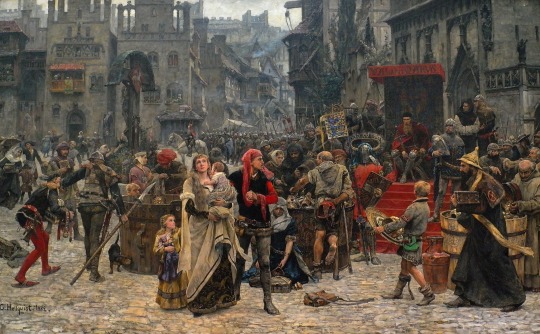
Valdemar Atterdag holding Visby to ransom, 1361
by Carl Gustaf Hellqvist
#carl gustaf hellqvist#art#painting#history#valdemar iv#danish#king#visby#gotland#gotlandic#denmark#swedish#sweden#valdemar#battle of visby#europe#european#medieval#island
18 notes
·
View notes
Photo

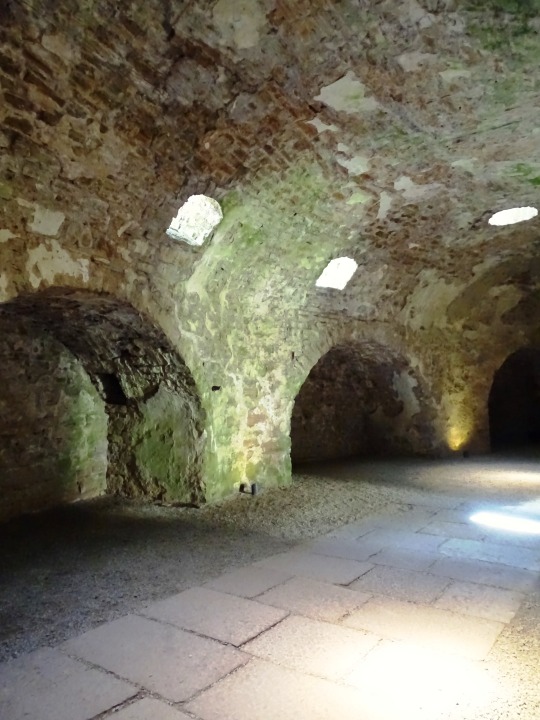
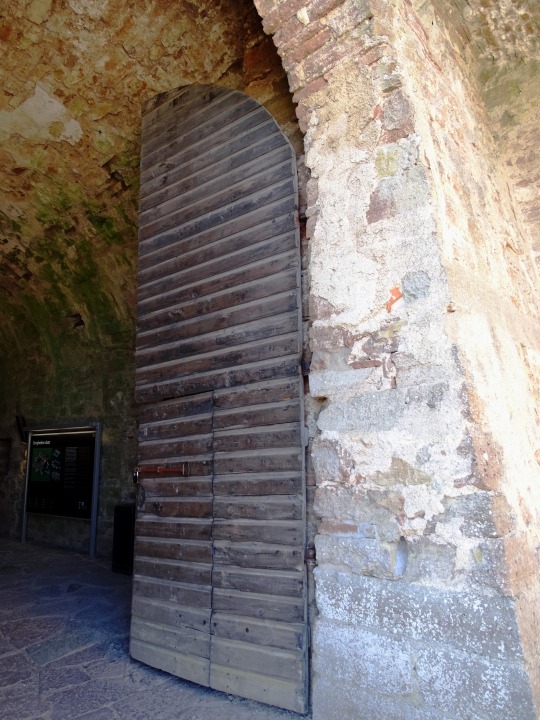
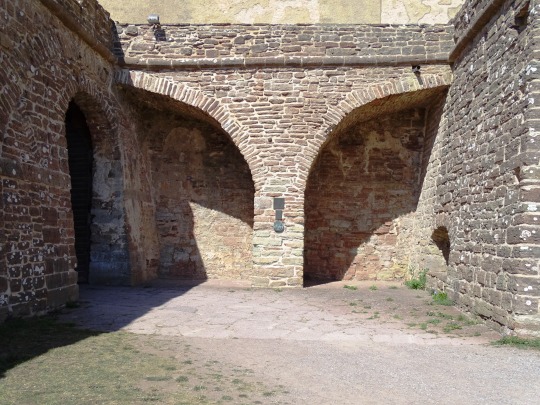
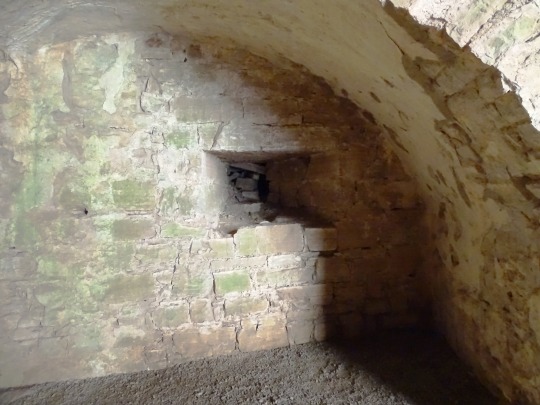



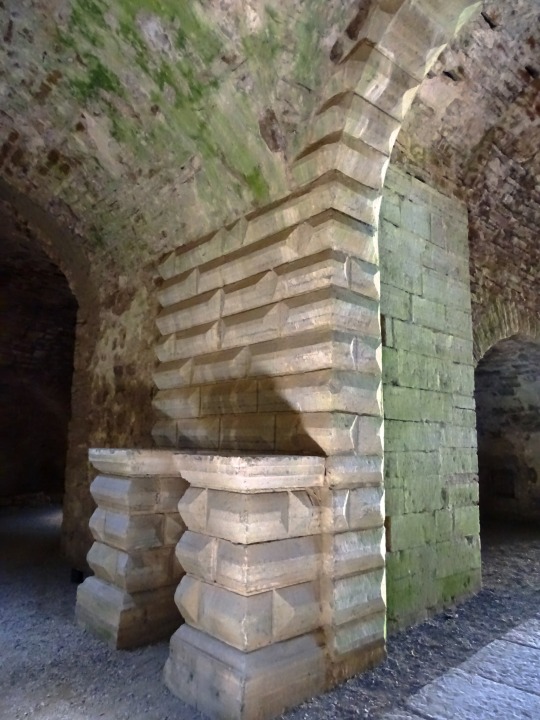
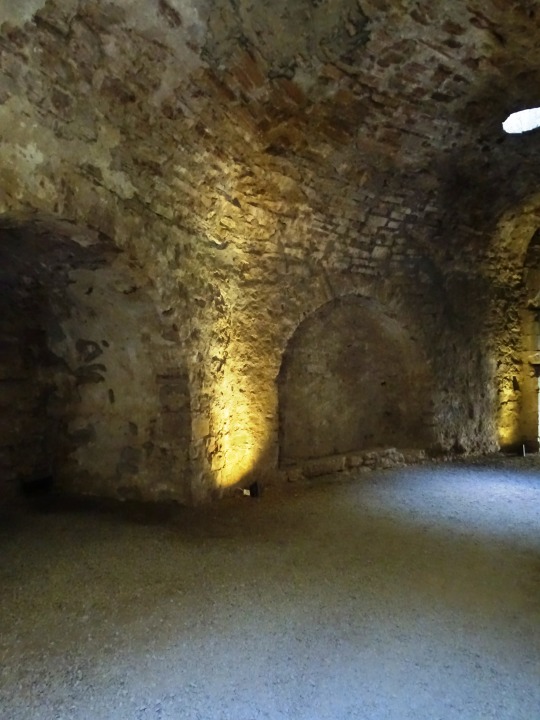
Borgholm Castle, Sweden (No. 2)
The construction of the original fortress was probably ordered by King Canute I, although this is not totally certain. He reigned 1167–1195 and had fortresses built on the Swedish east coast as defence against enemies from the other side of the Baltic Sea. During the 13th to 15th centuries, additions and changes were made. For example, new towers were built, and a new and thicker wall was constructed. The fortress was damaged on a number of occasions during these centuries, including in 1361, when King Valdemar IV (Atterdag) of Denmark attacked Borgholm.
During the Kalmar Union, many castles and fortresses in Sweden were damaged as a result of the ongoing conflicts between Danes and Swedes. When Gustav Eriksson became Swedish king and the union was dissolved, he, together with the sons that followed him on the throne, invested huge sums of money in repairing these buildings. It was Gustav's son John III (r. 1568–1592) who ordered the reconstruction of Borgholm into a renaissance castle. During his reign, the Pahr brothers (four engineers and architects from Milan) led a significant rebuilding that took place from 1572. The castle acquired a Gothic character and became exemplary of the Italianate bastion style.
Source: Wikipedia
#Ryttargången#knight's hallway#interior#exterior#Borgholm Castle#Sverige#Borgholms slott#Kalmar County#Dominicus Pahr#Johan Baptista Pahr#Nicodemus Tessin the Elder#Baroque#ruins#tourist attraction#landmark#Öland#island#summer 2020#original photography#Sweden#Scandinavia#Northern Europe#architecture#Swedish history#archaeology#arches#window#stone wall#engineering
3 notes
·
View notes
Text
(TENTATIVE) LIST OF DANISH KINGS WHOSE NAMES COULD ALSO BE THOSE OF WARRIOR CATS
Harald Wartooth (Wartooth?)
Sigurd Snake-in-the-eye (Snakeeye)
Harald Bluetooth (Bluetooth)
Svend Forkbeard (Splitfur?)
Valdemar Atterdag (Secondday? Sunrise?)
HONORABLE MENTIONS
Harold Harefoot, Danish King of England (but not Denmark) (Harefoot)
Eric Evergood (There's something here but I can't put my finger on it.)
Erik the Lamb (We've a prefix but not a suffix.)
2 notes
·
View notes
Text
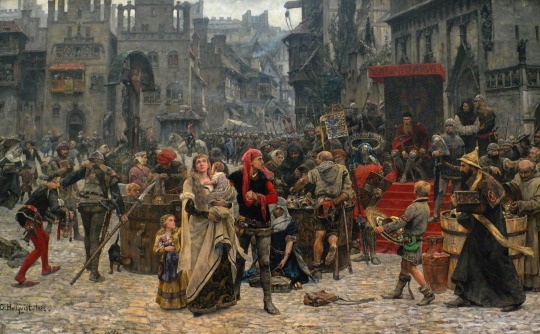
“Valdemar Atterdag holding Visby to ransom, 1361”
Karl Gustaf Hellqvist (1882)
1 note
·
View note
Note
Do you live with any Brazilian or any Portuguese person? Asking cuz "Valdemar" is a pretty common name in portuguese!
No Brazilians or Portuguese as of currently. In this context Valdemar is actually an old Danish name! We’ve had multiple kings with the name (Valdemar Atterdag – who’s also coincidentally the first to use the Danish flag and so our flag day is named after him, Valdemar Sejr, Valdemar den Store), but it’s not a super common name these days.
It’s new people in and out of the apartment once or twice a year, ie. we’re getting a new volunteer from Venezuela in February. I know that there have been at least Portuguese people formerly, but I’m actually not sure about Brazilians – most volunteers are from Europe. Since August we’ve been two Danes, an Austrian, a Frenchman, a Tunisian (who actually didn’t arrive until late September because there were problems with his papers) and a Bangladeshi, but Arif from Bangladesh arrived in February 2019 and went home just a few weeks ago in the beginning of December
#personal#not a language#volunteer work#european solidarity corps#european volunteer service#Anonymous
4 notes
·
View notes
Text
Fortidsmindeprojekt, fiktiv tekst
En forårsaften, 1372...
En mand kommer ridende af de mudrede små-veje, hans ansigt er sammenbidt, og hestens man er dækket af små perler af sved. Det er kun ganske kort tid siden at han så faklerne, så mændene, og hestene, og vognene komme rundt omkring bakketoppen. Fra hans gårdsted i udkanten Aasted har han holdt udkik, mens han passede sine marker. Den ulidelige ventetid siden Hr. Krabbe gav ham, og nogle af de andre bønder besked på, at værne imod en væbnet styrke. Hr. Krabbe havde hørt at fæstningen Hald ved Viborg skulle være faldet, og at den fjendtlige styrke nu var på vej i retning mod Salling.
Endelig kunne han se faklerne, og lyset fra fæstningen på næsset i vandet, og i aftenens svindende lys, kunne han se Galgehøjens dystre omrids på sin venstre hånd. Vist havde han aldrig selv stjålet eller drevet ran, men med den rosa-røde sols forsvinden på den anden side af vandet, kunne han se en skikkelse, dingle svagt i aftenens stille vind. I skæret fra en fakkel, kunne han se to mænd i harnisk og hjelm stå, lige ved vandkanten hvor dæmningsvejen gik ud til fæstningen. Den ene med sit spyd og skjold, den anden sit skjold på ryggen. Fra hestens stønnende og forpustede åndedrag, og dens øjne stående hvidt i dens hoved, til mandens manglende udrustning, kunne de regne sig frem til at dette ikke var en af fjendens soldater. Manden, næsten lige så forpustet, eller måske skræmt, som hans hest, sagde blot, ”Slip mig igennem; fjenden kommer!”
Skønt det halvlune forårsvejr og højt solskin havde gjort dagen behagelig, var stemningen her på dæmningsvejen til Hr. Krabbes fæstning ganske trykkende. Det mørke, kolde vand på begge sider af den smalle vej, var om muligt mere skræmmende end de bevæbnede mænd, som manden havde set komme over og omkring bakken sydøst for Aasted. Han beroligede hesten, og satte farten ned. Dyret var et arbejdsdyr, til pløjning af marker samt til at trække vognen, når høsten skulle i hus. Skønt manden ikke ejede en saddel, var det alligevel hurtigere at ride på den, end skulle hans ben have ført ham frem i mørket. Endelig var han ved porten til Hr. Krabbes fæstning, broen var oppe og han steg af hesten, og hidkaldte vagtens opmærksomhed. ”Jeg bringer en vigtig besked til Hr. Krabbe! Fjendens mænd er i Aasted nu!” Broen blev ikke med det samme sænket; men bud blev sendt af sted til hovedbygningen. Snart efter tændtes flere fakler langs fæstningens palisader. Skulle fjenden komme helt herud, ville de få deres at se til mod Hr. Krabbes mænd. Nu blev broen sænket, langsomt lod de brede reb broen komme ned. Bonden klappede beroligende hesten, skønt han allerhelst ville ride så langt væk som muligt lige nu. Med et hult drøn var broen helt nede. Nu blev bonden vist ind af en vagt og to høje, bredskuldrede karle marcherede væk fra porthuset.
Den anspændte stemning var endnu mere udtalt her, hvor de røde gløder fra essen i fæstningens smedje afslørede et dystert et glimt af livet bag de høje palisader. Hr. Krabbe havde hyret tømrer og karle til at bygge denne fæstning for mindre end to år siden. Så længe Hr. Krabbe betalte var der ikke nogen der stillede nærgående spørgsmål, men snakken gik, når man var udenfor Hr. Krabbes hørevidde. Således var der en mand fra Nissum, der mente at Hr. Krabbe havde fornærmet en anden herremand fra Mors, og at fæstningen skulle bruges i den forbindelse.
Bonden havde ikke selv arbejdet på fæstningen, og det var første gang han havde været inden bag palisaderne. De aflange skjolde hver med et spyd stod klar. Enkelte af mændene bar også pilekoggere og buer, Hr. Krabbe havde ikke sparet på udstyret. Og fæstningen virkede også solid nok. Bonden var ikke helt tryg stemningen. Ud af øjenkrogen holdt han øje med en ung karl, der førte hans hest over en smal gangbro, til endnu en af fæstningens øer, hvor noget der lignede en stald var opført.
Hr. Krabbe selv kom ud, en presset mand kunne, bonden se. Bonden tog sin kutte af, og bøjede hovedet i respekt. I dette lys fra faklernes skær virkede Hr. Krabbe, som han kom der flankeret af bevæbnede mænd, og med et sværd ved siden, som en kriger. Bonden tog mod til sig og kiggede op, ”Hr. Krabbe, Hr. Krabbe! Fjenden kommer, ganske som De forudsagde! De står i Aasted nu!” Hr. Krabbe blev om muligt mere bekymret end de var før, han havde håbet på bedre tidener, og bedre tid til klargøre den nyligt opførte fæstning. Hans ansigtsudtryk til trods, var hans stemme rolig da han talte: ”Meget vel, og du er helt sikker på de kom denne vej, og ikke blot var rejsende?” Mens han talte havde Hr. Krabbe bevæget sig nærmere bonden, denne lugtede ikke af øl eller vin, og virkede klar i mælet. Bonden nikkede ivrigt, ”Jovist er jeg sikker, jeg kunne se deres hjelme skinne i faklerne, da de kom over bakken ved Aasted. Med sikkerhed vil de komme her inden midnat, Hr. Krabbe.” Hr. Krabbe nikkede eftertænksomt, ”Nu vel,” han vinkede til en af de unge karle, der havde taget sig af bondens hest, ”bring mig pergament og min fjerpen, og lad det gå lidt tjept!”. Den unge karl nikkede og løb ind hvor Hr. Krabbe just var kommet ud. Mens de ventede, takkede Hr. Krabbe bonden for hans troskab, ”Du er en mand af ære, hvad er dit navn, min gode mand?” Bonden så helt paf ud førend han svarede, ”Jeg er Jens-Peder, af Aagarden, Hr. Krabbe.”
Hr. Krabbe skrev ganske hurtigt, omend bonden ikke var i stand til at læse hvad der stod. Pergamentet blev rullet sammen og lukket med Hr. Krabbes segl, og Hr. Krabbe holdt det frem til bonden, ”Bring dette til min forpagter på min gård i Nissum, og du skal få din belønning.” Bonden bukkede dybt og stak det sammenrullede pergament ind under sit tunge slag. En række ordrer blev råbt til de bevæbnede mænd i Hr. Krabbes tjeneste, og bonden fandt sin hest iblandt køer og kvier i stalden. Han trak det godmodige dyr ud, over den smalle bro til den befæstede ø, og ud igennem porten. Først da han kom ud på dæmningsvejen med det mørke vand, satte han sig op fik hesten i trav. Vel inde på det faste land, drejede bonden hesten mod nord, det var næppe en god idé at blive stoppet af bevæbnede mænd sånær Galgehøjen. Således red han langs den mudrede bred, og i nattemørket bag ham, lod et horn sit dystre kald gjalde gennem luften.
Hr. Krabbe spejdede mod land. Det var nu flere dage siden at fjenden var ankommet, men ingen herold havde meldt fjendens hensigt, ingen rytter med krav om overgivelse. I stedet havde hans folk på fæstningen blot kunnet se til, imens at fjendens krigere arbejdede med at flytte store mængder jord. De spærrede vejen af, med blokader og svært bevæbnede; ingen fik lov til at komme ud til øen og fæstningen via dæmningsvejen. Det var tydeligt at fjenden ikke var interesseret i at kæmpe på Hr. Krabbes præmisser. Men Hr. Krabbe kunne se, ud fra lejren som blev bygget og de forsvarsværker der blev rejst, at denne styrke var stor, måske op til flere hundrede mand. Selv havde han blot tredive svende fra Nissum og de nærliggende landsbyer, som han havde betalt i dyre domme. I åben kamp, mod så stor en styrke, ville de blot blive slagtet.
De første tegn på desperation, indtrådte efter et par uger, en af de unge staldknægte tilbød at svømme over vandet til Nissum for, at bede Hr. Krabbes fjerne slægt om at komme til undsætning. Man havde fulgt knægtens svømmetag i skæret fra faklerne, indtil man ikke længere kunne se ham. Vist så han ud til at kunne svømme bedre end de fleste, men man hverken set eller hørt noget til knægten. Alt i mens var lejren på bredden blot vokset sig større og mere truende dag for dag. Hr. Krabbe beordrede at broen og porten skulle forblive lukket. Ikke så meget fordi han forventede et angreb i ly af mørket, men Hr. Krabbe vidste godt at hvis først een mand overgav sig, ville det ikke vare længe førend resten ville følge efter. Hans bedste chance var at holde ud indtil der kom forstærkninger, eller til den fjendtlige styrke besluttede sig for at drage videre. Det sidste virkede dog mere og mere usandsynligt, da lejren kun blev større og større, og Hr. Krabbe kunne have svoret på at endnu flere mænd havde sluttet sig til den belejrende hærstyrke.
Den sidste ko var slagtet, og rent vand var også slippe op. Flere af mændene beklagede sig højlydt, når de troede at Hr. Krabbe ikke lyttede. Også Hr. Krabbe begyndte at mærke manglen på nærmest alt. Han havde skrevet breve, før fjenden var ankommet, men havde ikke nået at få dem sendt. De fint-oprullede pergamenter med hans segl og sirlige håndskrift, lå nu på hans bord i rummet i hovedbygningen. Mændene opholdt sig på øen med den tomme staldbygning, skønt Hr. Krabbe havde sagt at alle tre øer skulle have vagt-poster, mest for at man kunne se hvorvidt fjenden ville angribe eller pakke sammen og drage videre. Hr. Krabbe havde hørt om sine forfædres bedrifter, som lensmænd og krigere under konger, om storslåede dueller om land og ære, og hans sværd var såmænd smedet af den bedste våbensmed i Aalborg, dets værdi kunne betale adskillige af de mænd han hyret. Men Hr. Krabbe var ingen kriger. I adskillige dage nagede tanken om, at han skulle forsvinde ud af denne verden, uden at have efterladt sig et mæle som var en stormand værdig. Hans hjelm stod pudset og klar. Skulle han drive mændene frem i et overraskelsesangreb? Der var nu gået så mange dage at fjenden næppe ville forvente det. Imens han tænkte, lukkede han sig inde i sit rum, og lod mændene klare dagligdagen.
Men Hr. Krabbes mænd kom hans egne tanker i forkøbet; der lød en skarp banken på hans dør, hans hånd var med det samme på sværdets skæfte. ”Hr. Krabbe, vi beder Dem lytte til vor bøn; lad os slippe vore våben og bede om nåde, vi har gårde og familier som venter derhjemme.” Hr. Krabbes første tanke var vrede over, at de mænd som han ellers havde vurderet var blandt de mest loyale folk i hele Salling, og som han havde betalt ganske vel, nu vendte ham ryggen. Disse kujoner skulle få lov til at smage hans sværd.
Men Hr. Krabbe havde også selv en familie, og det ville næppe gå ham vel, skulle han forsøge, ene mand, mod tredive karle samt den fjendtlige styrke efterfølgende. Måske var fjenden til at tale med? Hans tanker om gården derhjemme og hans egen familie, skubbede helt de glorværdige bedrifter som hans forfædre havde udført, ud af hans hoved. Det var, når det kom til stykket trods alt, bedre at miste ansigt, end at miste livet. Træt og afkræftet åbnede Hr. Krabbe døren; karlene stod klar med deres spyd og skjolde, deres ansigtsudtryk var fyldt af samme træthed og udmattelse som hos ham selv, men også med sammenbidte miner; de havde været klar til at bryde hans dør med magt, om nødvendigt. Hr. Krabbe løftede en åben hånd, han ville tale. Mændene var lidt usikre, Hr. Krabbe havde godt nok sit sværd ved siden, men var ikke i nærheden af at gribe til det. ”Ved daggry i morgen, vil jeg, at I alle kaster spyd og skjolde i vandet, fra den inderste ø. Således kan fjenden se det. Vi går dem i møde, under en hvid fane, med rejst pande, som stolte Sallingboere.”
Som sagt, så gjort. De trætte mænd lod, ved solens stråler, deres våben forsvinde ned i vandet, kun Hr. Krabbe lod sit sværd blive i bæltet. De to karle der stod for at sænke broen, som for nogle få uger siden havde været kraftfulde unge mænd, kunne nu ikke ikke engang holde broen oppe; de svære knuder løsnedes, og faldt broen med et brag. I samlet, forhutlet, flok drog Hr. Krabbe og hans mænd over den smalle dæmning, og da de kom nærmere bredden, kunne de se, at fra vandets kant og hele vejen op til Aasted, var omformet til en stor lejr. De høje jordvolde med stejle sider og palisader rejste sig over dem. En vagtpost fik øje på dem, og den hvide fane man havde lavet af Hr. Krabbes sengelinned. Han råbte ind til lejren, der straks begyndte at myldre af liv. Det gibbede i de trætte mænd, da de passerede imellem de første jordbanker, hvorpå bueskytter stod parate på begge sider over dem. De passerede stumme, sammenbidte mænd iført jern-hjelme og harnisk, og en rytter i ringbrynje ventede dem midt inde i den store lejr. Bortset fra den karl der bar fanen, og Hr. Krabbe selv, lod alle mændene deres åbne hænder løfte over hovederne, i tegn på overgivelse.
Således slutter historien om Hr. Krabbe og fæstningen på Sallingholm, hvad der skete med Hr. Krabbe og mændene vides ikke, men fæstningen var virkelig og tiden blev dens fjende. Den fjende der havde belejret dem, var ingen anden end Kong Valdemar, ham der siden fik tilnavnet Atterdag. Han samlede det danske rige efter lang tid pantsættelse til Holstenske og Lübske hertuger – men det var ikke alle, der overgav sig frivilligt. Herremanden på Sallingholm var en af dem udstod en belejring, førend han måtte bøje sig for overmagten.
#Dansk#Sallingholm#Krabbe-slægten#Valdemar Atterdag#Middelalder#Multi-Medie Projekt#Fiktiv tekst#Historie
0 notes

